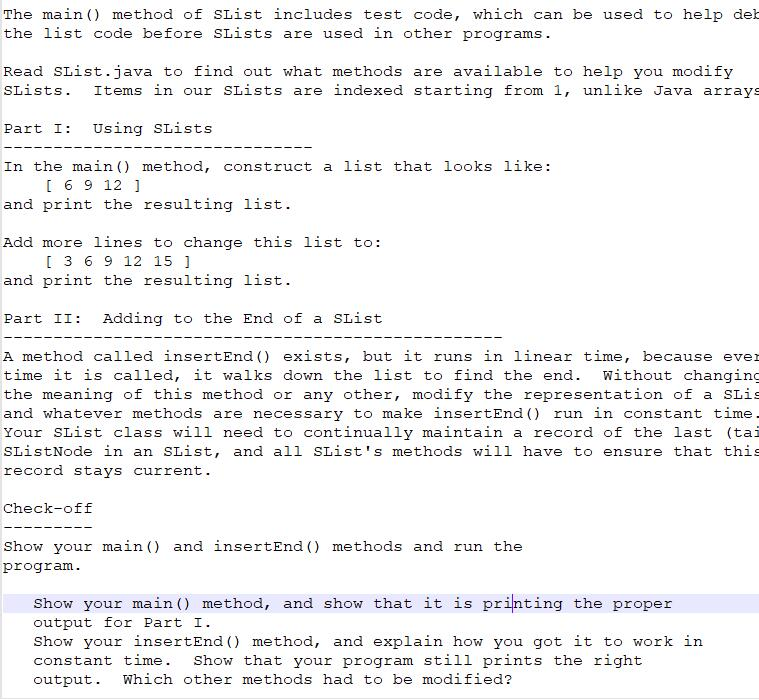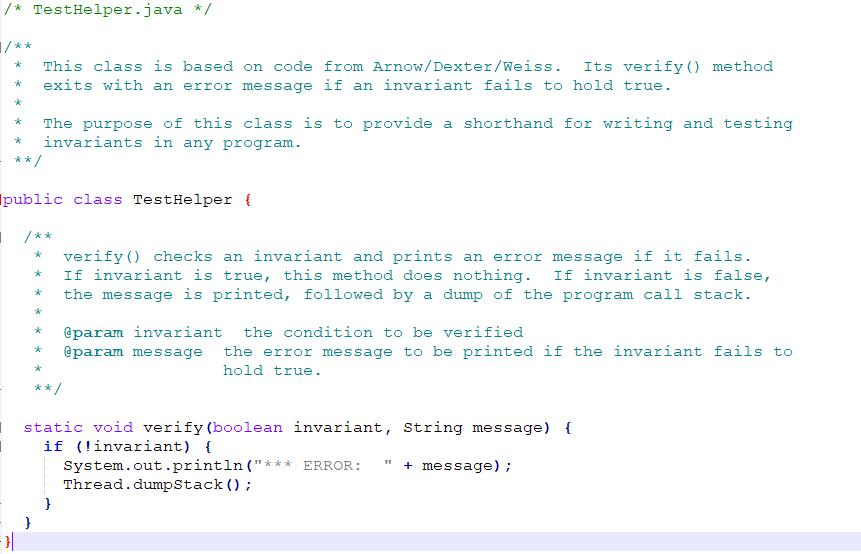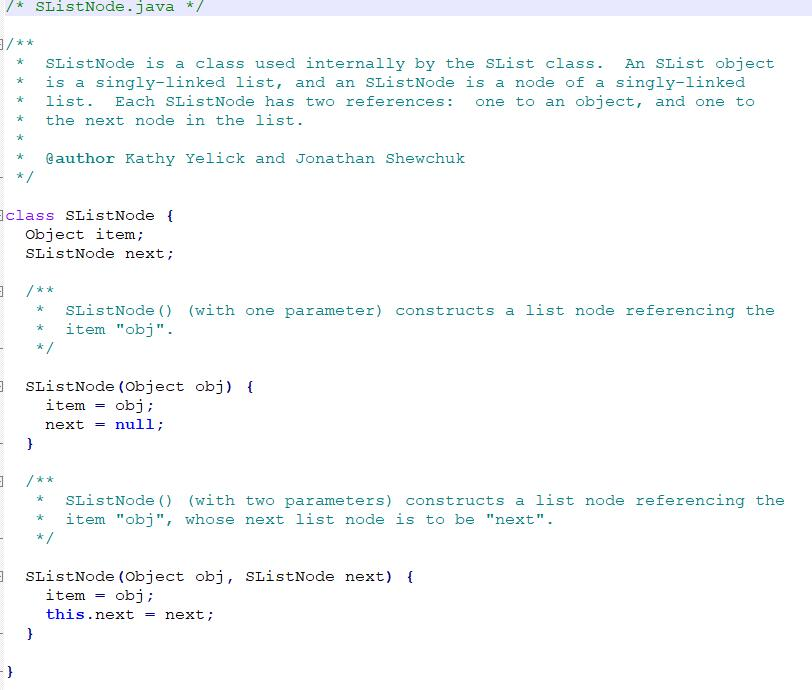Question
/* SList.java */ /** * The SList class is a singly-linked implementation of the linked list * abstraction. SLists are mutable data structures, which can



/* SList.java */
/**
* The SList class is a singly-linked implementation of the linked list
* abstraction. SLists are mutable data structures, which can grow at either
* end.
*
* @author Kathy Yelick and Jonathan Shewchuk
**/
public class SList {
private SListNode head;
private int size;
/**
* SList() constructs an empty list.
**/
public SList() {
size = 0;
head = null;
}
/**
* isEmpty() indicates whether the list is empty.
* @return true if the list is empty, false otherwise.
**/
public boolean isEmpty() {
return size == 0;
}
/**
* length() returns the length of this list.
* @return the length of this list.
**/
public int length() {
return size;
}
/**
* insertFront() inserts item "obj" at the beginning of this list.
* @param obj the item to be inserted.
**/
public void insertFront(Object obj) {
head = new SListNode(obj, head);
size++;
}
/**
* insertEnd() inserts item "obj" at the end of this list.
* @param obj the item to be inserted.
**/
public void insertEnd(Object obj) {
if (head == null) {
head = new SListNode(obj);
} else {
SListNode node = head;
while (node.next != null) {
node = node.next;
}
node.next = new SListNode(obj);
}
size++;
}
/**
* nth() returns the item at the specified position. If position
* position > this.length(), null is returned. Otherwise, the item at
* position "position" is returned. The list does not change.
* @param position the desired position, from 1 to length(), in the list.
* @return the item at the given position in the list.
**/
public Object nth(int position) {
SListNode currentNode;
if ((position
return null;
} else {
currentNode = head;
while (position > 1) {
currentNode = currentNode.next;
if (currentNode == null) {
return null;
}
position--;
}
return currentNode.item;
}
}
/**
* toString() converts the list to a String.
* @return a String representation of the list.
**/
public String toString() {
int i;
Object obj;
String result = "[ ";
SListNode cur = head;
while (cur != null) {
obj = cur.item;
result = result + obj.toString() + " ";
cur = cur.next;
}
result = result + "]";
return result;
}
/**
* main() runs test cases on the SList class. Prints summary
* information on basic operations and halts with an error (and a stack
* trace) if any of the tests fail.
**/
public static void main (String[] args) {
// Fill in your solution for Part I here.
System.out.println("Kamran Eftekhari");
//testEmpty();
//testAfterInsertFront();
//testAfterInsertEnd();
}
/**
* testEmpty() tests toString(), isEmpty(), length(), insertFront(), and
* insertEnd() on an empty list. Prints summary information of the tests
* and halts the program if errors are detected.
**/
private static void testEmpty() {
SList lst1 = new SList();
SList lst2 = new SList();
System.out.println();
System.out.println("Here is a list after construction: "
+ lst1.toString());
TestHelper.verify(lst1.toString().equals("[ ]"),
"toString on newly constructed list failed");
System.out.println("isEmpty() should be true. It is: " +
lst1.isEmpty());
TestHelper.verify(lst1.isEmpty() == true,
"isEmpty() on newly constructed list failed");
System.out.println("length() should be 0. It is: " +
lst1.length());
TestHelper.verify(lst1.length() == 0,
"length on newly constructed list failed");
lst1.insertFront(new Integer(3));
System.out.println("Here is a list after insertFront(3) to an empty list: "
+ lst1.toString());
TestHelper.verify(lst1.toString().equals("[ 3 ]"),
"InsertFront on empty list failed");
lst2.insertEnd(new Integer(5));
System.out.println("Here is a list after insertEnd(5) on an empty list: "
+ lst2.toString());
TestHelper.verify(lst2.toString().equals("[ 5 ]"),
"insertEnd on empty list failed");
}
/**
* testAfterInsertFront() tests toString(), isEmpty(), length(),
* insertFront(), and insertEnd() after insertFront(). Prints summary
* information of the tests and halts the program if errors are detected.
**/
private static void testAfterInsertFront() {
SList lst1 = new SList();
lst1.insertFront(new Integer(3));
lst1.insertFront(new Integer(2));
lst1.insertFront(new Integer(1));
System.out.println();
System.out.println("Here is a list after insertFront 3, 2, 1: "
+ lst1.toString());
TestHelper.verify(lst1.toString().equals("[ 1 2 3 ]"),
"InsertFronts on non-empty list failed");
System.out.println("isEmpty() should be false. It is: " +
lst1.isEmpty());
TestHelper.verify(lst1.isEmpty() == false,
"isEmpty() after insertFront failed");
System.out.println("length() should be 3. It is: " +
lst1.length());
TestHelper.verify(lst1.length() == 3,
"length() after insertFront failed");
lst1.insertEnd(new Integer(4));
System.out.println("Here is the same list after insertEnd(4): "
+ lst1.toString());
TestHelper.verify(lst1.toString().equals("[ 1 2 3 4 ]"),
"insertEnd on non-empty list failed");
}
/**
* testAfterInsertEnd() tests toString(), isEmpty(), length(),
* insertFront(), and insertEnd() after insertEnd(). Prints summary
* information of the tests and halts the program if errors are detected.
**/
private static void testAfterInsertEnd() {
SList lst1 = new SList();
lst1.insertEnd(new Integer(6));
lst1.insertEnd(new Integer(7));
System.out.println();
System.out.println("Here is a list after insertEnd 6, 7: "
+ lst1.toString());
System.out.println("isEmpty() should be false. It is: " +
lst1.isEmpty());
TestHelper.verify(lst1.isEmpty() == false,
"isEmpty() after insertEnd failed");
System.out.println("length() should be 2. It is: " +
lst1.length());
TestHelper.verify(lst1.length() == 2,
"length() after insertEndfailed");
lst1.insertFront(new Integer(5));
System.out.println("Here is the same list after insertFront(5): "
+ lst1.toString());
TestHelper.verify(lst1.toString().equals("[ 5 6 7 ]"),
"insertFront after insertEnd failed");
}
}
The main) method of SList includes test code, which can be used to help deb the list code before SLists are used in other programs Read SList.java to find out what methods are available to help you modify SLsts. Items in our SL1sts are indexed starting from 1, unlike Java arrays Part I Using SLists In the main method, construct a list that looks like: and print the resulting list Add more lines to change this list to: and print the resulting list Part II: Adding to the End of a slist [6 9 12 ] 3 6 9 12 15 1 A method called insertEnd ) exists, but it runs in linear time, because ever time it is called, it walks down the list to find the end Without changing the meaning of this method or any other, modify the representation of a SLi and whatever methods are necessary to make insertEnd ) run in constant time Your SList class will need to continually maintain a record of the last (tai SLstNode in an SL1st, and all slist's methods will have to ensure that this record stays current. Check-off Show your main) and insertEnd () methods and run the program show your main() method, and show that it is printing the proper output for Part I. Show your insertEnd method, and explain how you got it to work in constant time. Show that your program still prints the right output. Which other methods had to be modifiedStep by Step Solution
There are 3 Steps involved in it
Step: 1

Get Instant Access to Expert-Tailored Solutions
See step-by-step solutions with expert insights and AI powered tools for academic success
Step: 2

Step: 3

Ace Your Homework with AI
Get the answers you need in no time with our AI-driven, step-by-step assistance
Get Started


